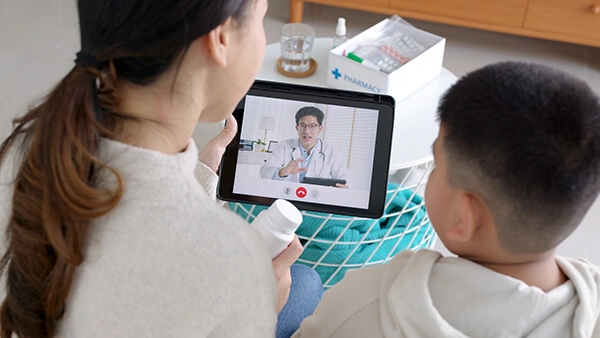Psychiatry, Mental Health Care for
Depression, Anxiety & More
Harmony United Psychiatric Care is one of Florida’s most reliable and compassionate mental health clinics.
Practice Highlights:
- Treatment for Adults, Adolescents & Children, ages 5 & above
- In-Clinic & Online Telepsychiatry / Telehealth Care
- Appointments are typically available same day or the next day
- Most Insurance Plans Accepted
- Affordable pricing for self-paying Clients
- Qualified, knowledgeable, and compassionate mental health professionals.
- Individualized and Evidence-based Care.
- Appointments are available in the evening and on weekends.
- Customer Service is available 7 days a week Monday – Sunday from 7:15 AM to 6:45 PM.
- On-Call Service is available 24 x 7 to attend to urgent client needs.

Psychiatry with Compassion
Our team includes Psychiatrists, Psychologists, Psychiatric Mental Health Nurse Practitioners, Physician Assistants, Licensed therapists, and counselors. We provide in-person as well as online, telemedicine, telehealth, telepsychiatry, and teletherapy services. We treat a wide range of psychiatric conditions, including Depression, Anxiety, Bipolar Disorders, ADHD, PTSD, and more.
Why choose Harmony United Psychiatric Care?
At Harmony United Psychiatric Care, each person we serve is treated with compassion and respect. We believe in each individual’s potential for personal growth, and we strive to provide the best treatment possible through individualized, evidence-based care.
We provide comprehensive treatment options, blended with empathy and concern for our client’s well-being. Our Psychiatrists, Psychiatric Mental Health Nurse Practitioners, Psychologists, Licensed Therapists, Counselors, and Physician Assistants stay up to date on the latest developments in psychiatric care and are well-informed on cutting-edge treatment modalities in the field of psychiatry.
We are one of Florida’s most reliable and compassionate mental health clinics. We have flexible work hours. We provide appointments in the evenings as well as on weekends.
Mental Health Disorders: A Comprehensive Guide
Mental health disorders are conditions that affect a person’s thinking, mood, and behavior. These disorders can vary widely in severity, duration, and impact on daily life. Some of the most common mental health disorders include depression, anxiety disorders, bipolar disorder, schizophrenia, post-traumatic stress disorder (PTSD), obsessive-compulsive disorder (OCD), and eating disorders like anorexia and bulimia.
While there is no single cause of mental health disorders, they are often the result of a combination of genetic, environmental, and social factors. In some cases, they may be triggered by traumatic events, such as abuse or neglect, or by chronic stress and life challenges.
Despite their prevalence, mental health disorders are often stigmatized and misunderstood. Many people believe that these conditions are not “real” diseases, or that they are a sign of weakness or personal failing. However, research has shown that mental health disorders are indeed biological and medical conditions that require treatment and support.
A psychiatric evaluation and a mental health disorder test (Neurocognitive and Neuropsychological)can help diagnose conditions like Autism, ADHD, Traumatic Brain Injury,Learning problem/Disability, Memory Loss,Mood Disorders, Psychotic Disorders, Personality Disorders, Malingering, and others.
If you think you may be experiencing a mental health disorder, it is important to seek help from a qualified mental health professional (Psychiatrists, Psychiatric Mental Health Nurse Practitioners, Psychologists, Licensed Therapists, Counselors, and Physician Assistants). A psychiatric evaluation and Neurocognitive or Neuropsychological tests or assessments can help identify the specific condition you are dealing with and guide your treatment options.
We Accept Most Insurances
Including Medicare
Find a Provider Who Meet Your Needs
Harmony United Psychiatric Care provides comprehensive medical services to patients in the Florida region. We accept a wide range of insurance plans, and we have compiled a comprehensive list of the insurance plans we accept on our website. Go to Accepted Insurance to view a complete list of insurance plans we accept. We understand that navigating the complexities of insurance can be overwhelming, so we have made it easy for patients to check if their insurance is accepted at Harmony United Psychiatric Care.
Our website lists all the major insurance providers including Medicare, Blue Cross Blue Shield (Federal and all states), Florida Blue, United HealthCare (Optum Medicare and Commercial),Cigna (Evernorth Behavioral Health), Humana, Magellan(Care Plus), WellCare, Provider Network of America (PNOA) and others. Being in-network with these major insurance providers allows us to provide patients with a range of healthcare plans that are tailored to their specific needs.
At Harmony United Psychiatric Care, we believe that quality healthcare should be accessible to all. That’s why we strive to work with as many insurance providers as possible to ensure that our patients receive the care they need. If you have any questions about your insurance plans or the services we offer, please don’t hesitate to contact us at P: 800 457-4573, F:(800) 443-6422 and E: [email protected].
Difference between a Psychiatrist and a Psychologist?
People are often confused between psychiatrists and psychologists while seeking professional help. Most of us do not know where to start. Who should a mental health professional be: a psychiatrist or a psychologist?
They both study the brain, emotions, feelings, and thoughts. However, their technical environment is not the same.
Psychiatrist
Psychiatrists attend medical school for four years and four to five years of residency/fellowship training. Psychiatrists can prescribe medications, conduct psychiatric evaluations and provide psychotherapy and counseling.

Psychologist
Psychologists typically undergo a Ph.D. program in Psychology for a minimum of five years, they conduct psychiatric evaluations, Neuropsychological and Neurocognitive testing, and provide psychotherapy and counseling to the clients. In some states, Psychologists are allowed to prescribe medications however, in the state of Florida psychologists are not allowed to prescribe medications.
Patient Testimonials
All testimonials from Google Reviews





